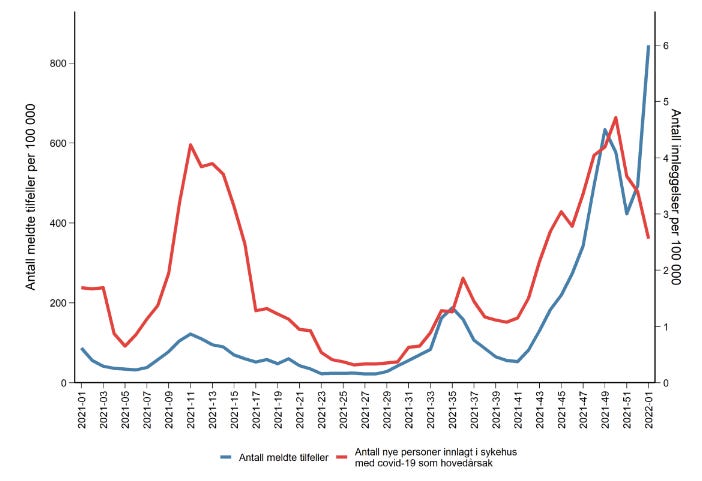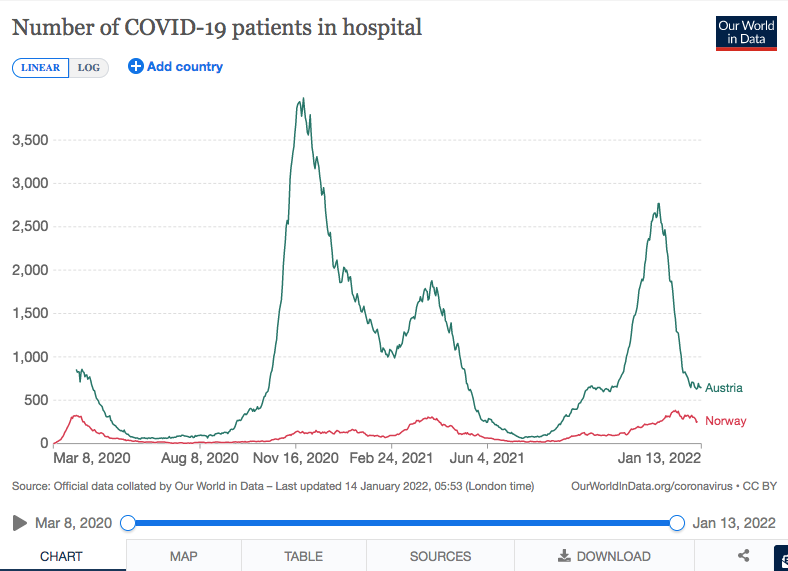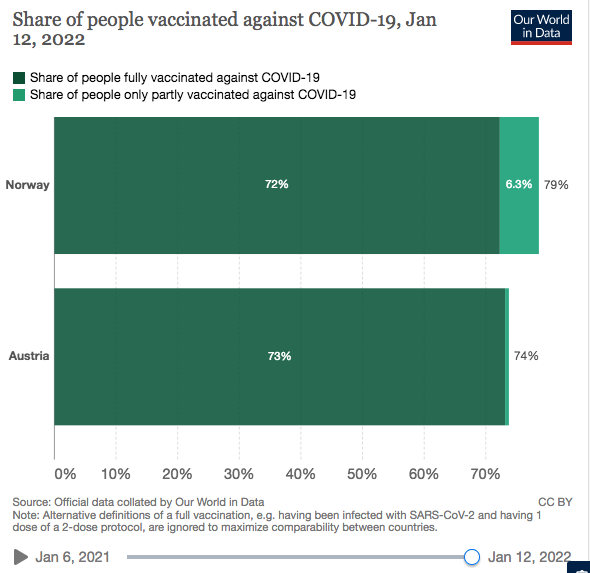Covid in Norway—the State of Play in mid-January, pt. 2: Epidemiological Evidence of Medical Malpractice and Sinking (dropping) VE point squarely to Massive Public Policy Failure
Also: it appears that the Government is (re-) assertings its authority over public health officialdom, which is good news--plus a comparison with Covidistan; spoiler alert: Norway fares better
Yesterday’s post focused on current epidemiological developments, so today it’s time to look at the political the consequences. As I mentioned in that post, there is now some 4+ weeks of data and real-world experience of or with Omicron in Norway, hence the main finding of the Institute of Public Health’s (IPH) most recent weekly report (fig. 3, p. 9):
The graph shows the ‘decoupling’ between ‘positive tests’ (the blue line) and ‘hospital admissions with Covid-19 as main cause’ (the red line). The lines crossed around the end of the year, which is consistent with the somewhat bigger picture offered by the IPH’s new risk assessment (dated 12 Jan. 2022).
Hospitalisations for Covid-19 peaked right around Christmas (week 50-51, p. 8, the below quote on p. 10), and the IPH will apparently never tire of pointing out that ‘during this period, around 58% of hospitalised patients was unvaccinated, although this group constitutes only a tenth of the adult population’.
Both of these facts are correct: in the population aged 45+, 94% are ‘fully vaccinated’ (2 jabs), and 70% have recently received a booster jab (table 1, p. 11-12). Still, the IPH continues to scare-monger by pointing out that unvaccinated patients are younger (median: 56) and ‘only 30% have underlying [or pre-existing] conditions that put them at moderate or high risk for a severe progression of Covid-19’. (Basically, if you’re under 70 and just about ‘generally healthy’, you won’t fall into these higher risk groups; for a discussion of the ‘definitions’ of these risk groups, see here).
Also, there is nothing new in this report, which—again—points to a pre-print by Whittaker et al. to ‘bolster’ their argument about ‘unvaccinated’ hospital admissions and risk. As I’ve pointed out before, the IPH did this in its pre-Christmas fear porn present, and they are doing it again in this mid-January fear porn present.
As an aside, the IPH may be forgiven for linking to the ‘old’ version dated 9 Nov. 2021 in its pre-Christmas assessment; but they still use the same link, even though, if you click on it, it says in bright red ‘view current version of this article’:
Apart from this, as I pointed out before, this is very disingenuous of the IPH: not only because that paper—which hasn’t been peer-reviewed—is all pre-Omicron (it looks at data from 1 Feb. through 30 Sept. 2021), used an ‘interesting’ method (small sample size of 2,361 patients, of whom a mere 253 or some 11% of the total were partially or fully vaccinated), which resulted in this ‘finding’ (p. 2, my emphasis):
We observed no difference in the [Length of Stay] for patients not admitted to ICU, nor odds of in-hospital death between vaccinated and unvaccinated patients.
Why this piece of junk is still used as a reference by the IPH is anyone’s guess, and I shall deal with this in a later post.
What does the IPH’s new assessment tell us?
Well, Omicron has displaced Delta, they estimate its R0 at ‘between 1.4-2.2’, but this is nothing more than a guess. Among hospitalised patients from week 50 through week 1, 117 had Omicron (out of 1,019), but the real kicker is the ICU side of admissions: of a total of 177 ICU patients, 5 (!) had Omicron, with the rest presumably being Delta; in week 1, 2 out of 20 ICU patients had Omicron (p. 11).
Children and adolescents are hardly affected, the IPH continues: a mere 13% of all Norwegian kids had Covid-19 detected during the entire pandemic. There is something else (p. 11):
It is believed that a significant number of children have been infected without the infection being confirmed with a test.
Do tell, who would’ve thought. Still, the IPH won’t dare to guess about how big that share of kids and teens might be. As a parent of two kids who attend primary school and kindergarten without ever catching as much as a cold in the past two years, here’s a shout-out: if kids aren’t symptomatic, why should you care? Also: dear public health agencies, if you’d like me or anyone to care about this issue, provide numbers.
I’ll spare you the majority of the rest of the assessment (it makes for bad reading, and, truth be told, if my students worked as sloppy as the IPH, I’d return the assignment). As an aside, let it be known that the report then veers off the reservation quite a bit and addresses ‘other respiratory illnesses’ (p. 12-17) before quoting, at length, data from Denmark and the UK (p. 12-17). I’ll spare you the details, for the IPH goes on to make bold claims about vaccine efficacy based on undated pre-prints (presumably) deposited at GoogleDrive that discuss in-vitro studies with pseudoviruses and data from Pfizer and Moderna (e.g., p. 21-22, n. 23 and 24), among others.
The assessment here is replete with one-sentence paragraphs about this or that study, but very light on analysis (p. 21-24). Finally, on p. 24, the IPH admits that
unvaccinated people…had the same odds of being infected with Omicron as fully vaccinated [two jabs], and that a booster jab had a significantly lower odds ratio
(For those interested enough, there’s more on VE in Denmark, the UK, and Canada on p. 25-28. This part of the report is particularly poorly done, and I’d certainly be unhappy if my students would do that.)
Yet, there is something of interest in this assessment, and it’s tucked away in a few paragraphs ‘On Immunity in General’ (p. 28, my emphases), which give away the game:
Current knowledge suggests that for adults two doses of mRNA vaccine [doesn’s say which one] provide somewhat better protection against infection in the first months after the second dose than infection, yet protection decreases faster after vaccination. The protection against serious illness and death seems to be very good for both [no data cited]. It is likely that natural immunity after infection [in unvaccinated, apparently] will provide somewhat more long-lasting and broader protection (against different variants) compared to those who chose the primary vaccination regimen with current mRNA vaccines, and [it is likely] that the best protection is obtained when immunity after infection is enhanced with a vaccine, so-called hybrid immunity. Preliminary data indicate that this also applies to infection after vaccination [again, no data cited]. There is insufficient knowledge to draw definite conclusions, and there are data that suggest that this difference may be somewhat smaller when the vaccine interval is longer than 3 weeks [the original says ‘uker’, i.e., weeks, but it’s months] (12-16 weeks).
In other words: natural immunity is preferred, because the current crop of mRNA gene therapeutics doesn’t last half a year, and post-vaccination protection might not have an impact if a ‘breakthrough infection’ occurs 12-16 weeks after the second jab.
Well, congratulations to anyone who elected to get jabbed at the ‘suggestion’ of his or her government and public health authorities: you bought yourself ‘protection’ for some 3 months.
As regards kids and ‘vaccines’, the assessment intimates that ‘children’s immune response after infection differs to some extent from adults’ in that
children are far often asymptomatic or have a mild course of the disease. Children have a faster and more efficient innate immune response in addition to being better at responding to new antigens, which makes it easier for children to control the SARS-CoV-2 virus and get rid of the virus faster than adults. After undergoing infection, children usually receive a broad and lasting adaptive immune response, and recent studies suggest a high level of protection against reinfection in children. Immunity after infection combined with vaccine appears to further increase protection.
This says: hold the horses, if you’re a parent and are considering the jabs.
Enough with this, here are the IPH’s main conclusions (p. 28-29; my emphasis):
Omicron has a greater immune evasion than Delta, and protection against (re-) infection appears also short-lived. This means that in our fully vaccinated population there are many who may be infected with Omicron and transmit the disease relative to Delta.
Omicron is more contagious and transmissible than Delta, due to Omicron affecting primarily the upper respiratory tract [which is actually good news].
Omicron’s shorter incubation period [relative to Delta] in effect means that the epidemic spreads faster and is more [I’d say: impossible] difficult to slow down known tracking methods…this also means that the R0 for Omicron may be lower than the earlier estimates and based on assumptions about its incubation period.
Studies on vaccine efficacy are early and small (with wide confidence intervals), and there are several possible sources of bias. Results must be interpreted with caution.
Parallel epidemics of Omicron and Delta are unlikely, since an Omicron infection appears to protect against Delta infection.
Given these ‘scientific’ findings—virtually all ‘good news’—, you’d be amazed to find out what’s happened in the public sphere.
IPH and the Public Health Authorities Battle the Elected Government
Last week, PM Støre let it be known that public health officials—mainly IPH Director Camilla Stoltenberg and IPH Infectious Disease Director Preben Aavitsland—would no longer be present at government press briefings.
I’d love to have been privy to internal IPH meetings and calls after the announcement, but judging from public statements over this past week, public health officials were quite likely very livid.
I won’t bore you with the details of last week’s developments (you may read up on them here), but here’s the gist: the IPH (the Norwegian CDC equivalent) and, oddly, the Confederation of Norwegian Enterprise (NHO, the Norwegian Chamber of Commerce equivalent) were pushing hard for the introduction of Covid Passports.
On Monday, the IPH published its ‘ready to go’ memo, only to rebutted by PM Støre who insisted that the government is not yet done thinking about it while ruling out their introduction on Friday (14 Jan.).
On Tuesday, at the same time the European Medicines Agency, held its first technical briefing of the year (watch here), Oslo’s leading daily Aftenposten pressed hard for the introduction of the Covid Passport to ‘clamp down on the unvaccinated’.
As a response, PM Støre and his government on Wednesday announced the formation of a new group of experts—with both IPH and NHO, but in a clearly subordinate position—to assess the situation and come up with recommendations. Led by economist Steinar Holden (Head of the Dept. of Economis, U Oslo; CV here), this appears to be a sign that the tide may be shifting.
This will make it easier to be able to adjust quickly depending on the infection situation and will create better predictability. In order for the package of measures to be as effective as possible, it is important to have more knowledge about the effects on society. The expert committee will contribute to these efforts, says Minister of Health Ingvild Kjerkol in the press release.
Yesterday evening, the government announced new measures, which effectively means a gradual re-opening despite all the pressure put forth by public health officials. As the website isn’t yet available in English (but in Norwegian), here’s the gist:
More normalcy for children and young adults—virtually no more limitations.
A new phase of the Corona Crisis has begun; it is impossible to stop Omicron.
Given the ‘decoupling’ of ‘case numbers’ and hospitalisations, the way forward is a higher tolerance for ‘cases’ and a more comprehensive approach to fighting Covid-19.
As regards Covid Passports, the government has announced it will ‘assess’ their introduction.
My Reading, as of today (14 Jan.)
So far, so good. It would appear that the time period in which public health officialdom was able to push around the government are coming to a close. Truth be told, I was a bit worried about the massive efforts by the IPH earlier this week, not so much because of the apparent pettiness of the main pushers over there, but because the worst estimates were amplified by the media.
I remember telling my spouse that it’s perhaps a 50:50 chance that the gov’t will hold out, but apparently, they did (so far). Truth be told, compared to, say, US or German-language media (esp. in Covidistan), Norwegian media, while similarly controlled by big business interests (here’s looking at you, Schibsted Group), offered quite a bit of variety—read: dissenting voices—in the past week; a casual, if selective, sampling would include the following items:
The IPH ceases to sequence swabs now that Omicron is dominant.
In the province of Vestland, 110,000 pupils were (rapid) tested earlier this week; 19 positive tests were recorded—at 7.2m Norwegian Crowns (720,000 €): more and more voices emerge who question this.
And, last but not least, already yesterday evening calls for doing away with most, if not all, of the remaining measures appeared.
It appears that the careful (dithering) way of ‘doing business’ in Norway may pay off for the resident population.
For some more perspective, how does Norway compare to Covidistan?
Also, given my coverage of Covidistan (most recently, see here and here), let’s just see how these two approaches compare:
And perhaps the most ‘surprising’ one:
There are, of course, differences, but the main point is: Norway has been far less restrictive-tyrannical, but it also fared much better than Covidistan.
We shall explore these issues in the near future.








